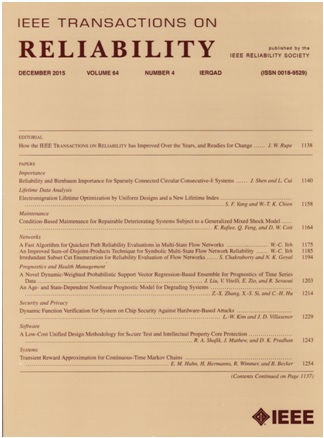基于距离的健康指示器及其在电力电子设备故障预测交互多模型中的应用
IF 5.7
2区 计算机科学
Q1 COMPUTER SCIENCE, HARDWARE & ARCHITECTURE
引用次数: 0
摘要
电力电子(PE)的可靠性对电动汽车的性能和安全性至关重要。因此,预测可能发生可预测退化的组件的剩余使用寿命(RUL)至关重要。在这里,我们提出了一个用于PE组件的规则估计框架。该框架有两个连续的阶段:通过无监督学习过程(如自组织图(SOM)或k均值聚类)生成基于距离的健康指标,以及随后部署相互作用的多模型(IMM),该模型将线性和扩展卡尔曼滤波器与各种退化概况集成在一起,以预测指标和RUL的未来值。具体来说,使用来自PE分量的状态中值信号数据来学习标称SOM或K-means模型。然后通过测量测试向量与聚类中心之间的距离来计算该指标。为了自适应地跟踪健康指标及其变化率,考虑到退化过程固有的噪声、各种退化曲线和测量系统,应用了imm。RUL是用预定义阈值与健康指标估计值之差除以当前降解率来评估的。该框架的验证涉及加速老化实验数据集,包括低频和高频切换场景。结果揭示了该框架的多功能性和跨不同应用程序实现的潜力。本文章由计算机程序翻译,如有差异,请以英文原文为准。
A Distance-Based Health Indicator and Its Use in an Interacting Multiple Model for Failure Prognosis in Power Electronic Devices
Power electronic (PE) reliability is critical to electric vehicle performance and safety. Thus, it is vital to predict the remaining useful life (RUL) of components that are subject to predictable degradation. Here, we propose a RUL estimation framework for PE components. The framework has two consecutive phases: Generation of distance-based health indicators through an unsupervised learning procedure, such as self-organizing map (SOM) or K-means clustering, and subsequent deployment of interacting multiple model (IMM) that integrate linear and extended Kalman filters with varied degradation profiles to forecast future values of the indicator and RUL. Specifically, a nominal SOM or K-means model is learned, using the on-state median signal data from the PE component. The indicator is then calculated by measuring the distance between the test vector and the cluster center. To adaptively track the health indicator and its rate of change, accounting for the noise intrinsic to degradation processes, various degradation profiles, and the measurement system, the IMMs are applied. The RUL is evaluated as the difference between a predefined threshold and the health indicator estimate, divided by the present degradation rate. Validation of the framework involved accelerated aging experimental datasets, encompassing both low-frequency and high-frequency switching scenarios. The results reveal the framework's versatility and potential for implementation across diverse applications.
求助全文
通过发布文献求助,成功后即可免费获取论文全文。
去求助
来源期刊

IEEE Transactions on Reliability
工程技术-工程:电子与电气
CiteScore
12.20
自引率
8.50%
发文量
153
审稿时长
7.5 months
期刊介绍:
IEEE Transactions on Reliability is a refereed journal for the reliability and allied disciplines including, but not limited to, maintainability, physics of failure, life testing, prognostics, design and manufacture for reliability, reliability for systems of systems, network availability, mission success, warranty, safety, and various measures of effectiveness. Topics eligible for publication range from hardware to software, from materials to systems, from consumer and industrial devices to manufacturing plants, from individual items to networks, from techniques for making things better to ways of predicting and measuring behavior in the field. As an engineering subject that supports new and existing technologies, we constantly expand into new areas of the assurance sciences.
 求助内容:
求助内容: 应助结果提醒方式:
应助结果提醒方式:


